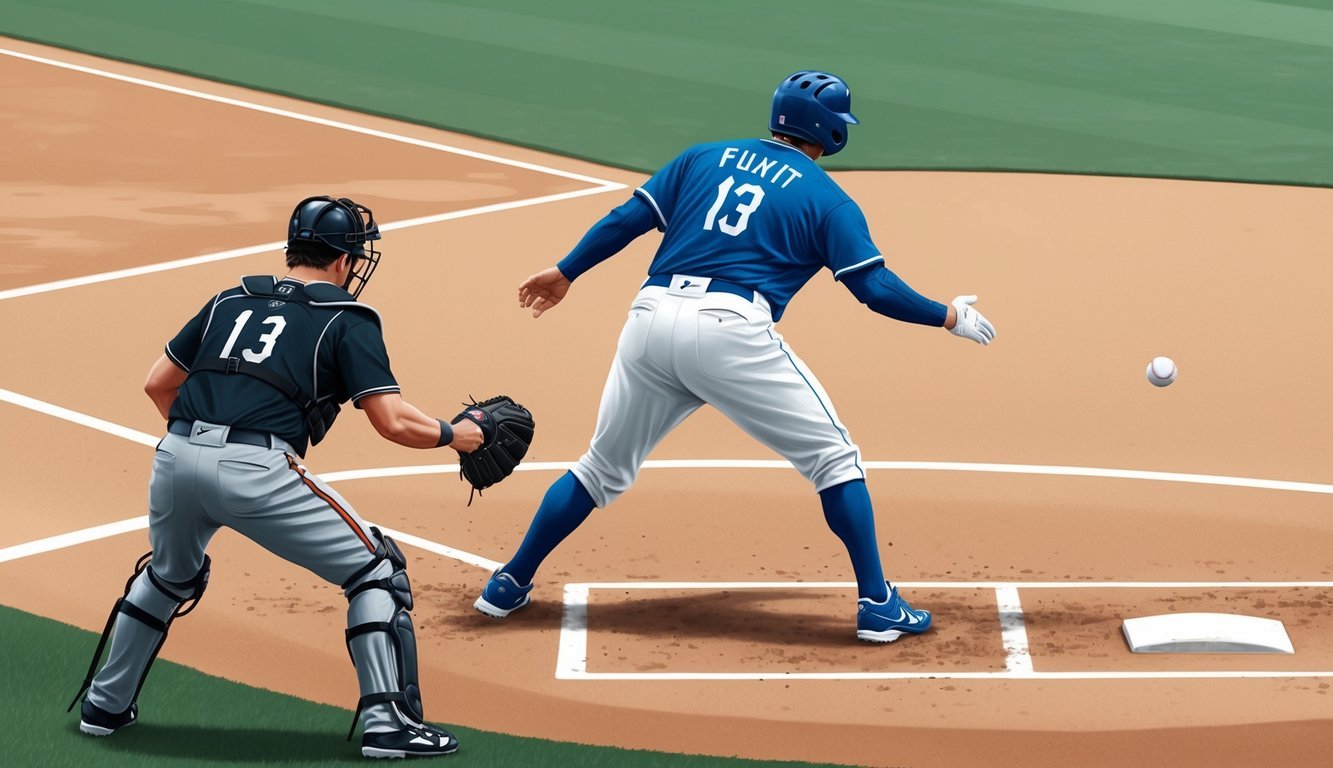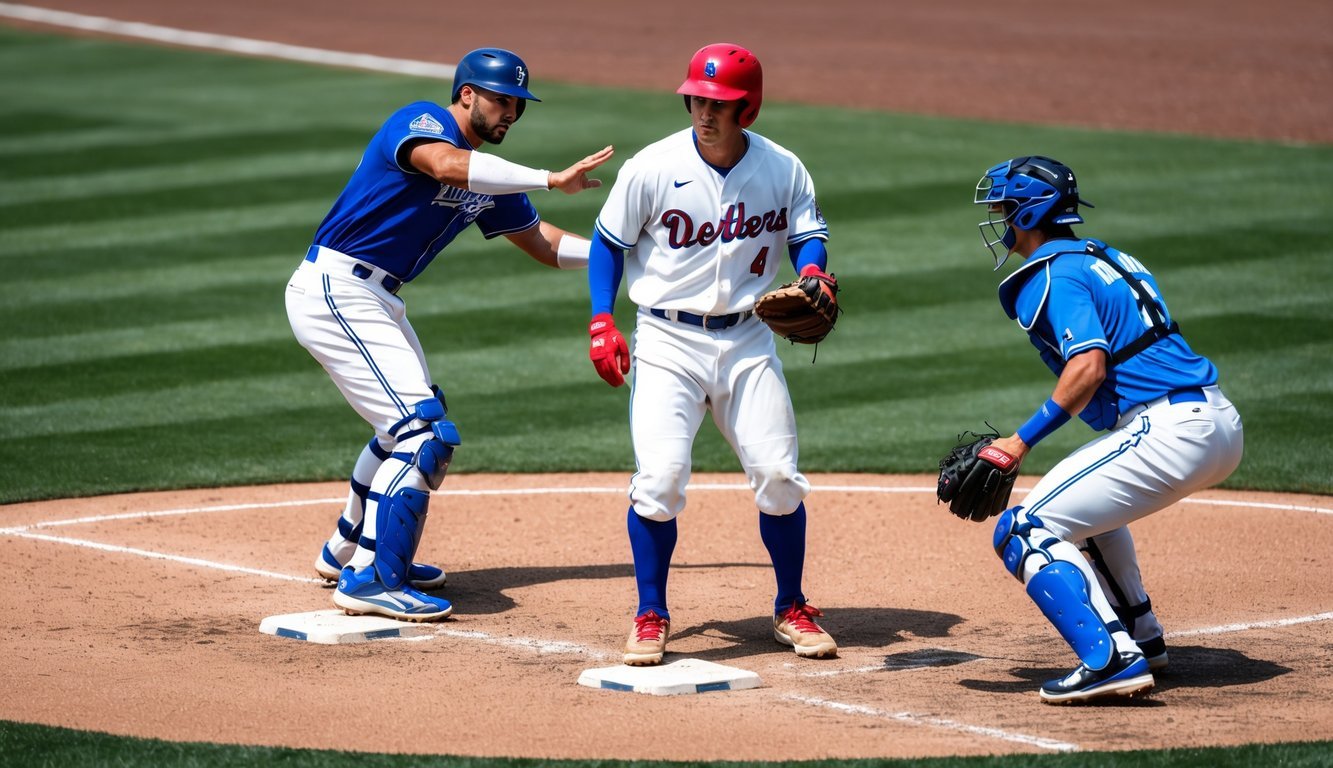In baseball, a fielder’s choice is a common play that often leads to confusion about statistics.
Many fans wonder if it counts as a hit when a batter reaches base safely on a fielder’s choice. A fielder’s choice does not count as a hit in baseball, even if the batter reaches base safely.
During a fielder’s choice, a defensive player has the option to put out a runner instead of the batter.
This play occurs when runners are on base and the fielder chooses to attempt an out on an advancing runner rather than the batter. The scorer records it as a fielder’s choice, not a hit, regardless of whether the attempted out is successful.
Understanding fielder’s choice is crucial for fans and players alike.
It impacts batting averages and on-base percentages, as the batter is charged with an at-bat but doesn’t receive credit for a hit.
This nuance adds depth to baseball strategy and statistics, making the game even more fascinating for those who delve into its intricacies.
Understanding Fielder’s Choice
A fielder’s choice is a common play in baseball that can be confusing for new fans.
It occurs when a defensive player opts to get an out or attempt an out on a runner instead of the batter-runner.
Definition of Fielder’s Choice
A fielder’s choice happens when a batter puts the ball in play and reaches base safely, but a defensive player chooses to make a play on another runner instead.
This often involves an infielder fielding a ground ball and throwing to a base other than first to get a force out or tag out.
The batter-runner is not credited with a hit in this situation.
Instead, they’re said to have reached on a fielder’s choice.
This play can occur even if no out is recorded, as long as the fielder attempted to get an out on another runner.
Comparison with Hits and Errors
Unlike hits, fielder’s choices don’t count toward a player’s batting average.
A hit occurs when a batter reaches base safely due to their own offensive action, without defensive mistakes.
Errors differ from fielder’s choices in that they involve defensive misplays.
An error is charged when a fielder fails to make a play they should have made with ordinary effort.
Fielder’s choices are neither hits nor errors.
They represent strategic decisions by the defense.
The official scorer determines whether a play is a hit, error, or fielder’s choice based on specific criteria and game situations.
The Role of the Official Scorer
The official scorer plays a crucial role in determining and recording fielder’s choice plays.
Their decisions impact key batting statistics and provide an accurate account of game events.
Determining a Fielder’s Choice
Official scorers carefully observe each play to identify fielder’s choice situations.
They assess whether a fielder had a reasonable opportunity to put out the batter-runner but chose to make a play on another runner instead.
This judgment requires a deep understanding of game situations and player capabilities.
Scorers consider factors like:
- The difficulty of the play
- The speed of runners
- The positioning of fielders
In close calls, the scorer may consult with team managers or review video footage to ensure accuracy.
Effects on Batting Average
When an official scorer rules a play as a fielder’s choice, it significantly impacts the batter’s statistics.
The batter is charged with an at-bat but does not receive credit for a hit.
This decision directly affects the player’s batting average.
For example:
- Batter hits a ground ball to shortstop
- Shortstop throws to second base for a force out
- Batter reaches first safely
In this case, the scorer would typically rule it a fielder’s choice.
The batter’s at-bat count increases, potentially lowering their batting average if they don’t get hits in subsequent plate appearances.
Scorers must be consistent in their rulings to maintain fair and accurate statistical records across all games and teams.
Fielder’s Choice in Play

A fielder’s choice is an exciting defensive play that can quickly shift the momentum of a baseball game.
It involves split-second decisions by fielders and often creates memorable moments on the diamond.
Common Scenarios
Infield ground balls frequently lead to fielder’s choice plays.
With runners on base, an infielder may opt to throw to second or third instead of first base.
This attempt to get the lead runner can result in a force out while the batter reaches safely.
Another common scenario occurs when a runner tries to score from third on a ground ball.
The fielder might throw home to prevent the run, allowing the batter to reach first.
Even if no out is recorded, it’s still a fielder’s choice if the fielder had a reasonable chance to get the batter out.
Sacrifice bunt situations can also lead to fielder’s choice plays.
The defense may choose to throw to an advancing runner rather than the batter at first base.
Strategic Considerations
Fielder’s choice plays involve crucial defensive decisions.
Teams must weigh the importance of preventing runs versus securing outs.
Holding runners or cutting off the lead runner can be vital in close games.
Fielders must assess runner speed, game situation, and the batter’s abilities when deciding where to throw.
A well-executed fielder’s choice can prevent a big inning or preserve a lead.
For batters, a fielder’s choice doesn’t count as a hit but can still drive in runs.
RBIs are awarded on fielder’s choice plays that score runs, except in force out situations at home plate.
Managers may instruct fielders on preferred plays in certain scenarios.
This pre-game strategy can help defenders make quick, effective choices when opportunities arise during play.
Fielder’s Choice Impact on Game Statistics

A fielder’s choice affects several key baseball statistics.
It counts as an at-bat but not a hit, influencing various player metrics.
Additionally, a fielder’s choice can impact a player’s on-base percentage and batting average since it does not add to their hit totals.
This nuance is particularly important for analysts and coaches when evaluating a player’s performance.
Speaking of statistics, understanding how equipment like the BBCOR baseball bat standard explained can influence game play is crucial for players aiming to optimize their performance on the field.
Batting and On-Base Percentages
Fielder’s choice plays a unique role in batting statistics.
It counts as an at-bat, potentially lowering a player’s batting average.
For example, if a batter goes 1-for-3 with a fielder’s choice, their average drops to .333 instead of .500 if it were a hit.
On-base percentage (OBP) is also impacted.
Since the batter reaches base but doesn’t get credit for a hit or walk, their OBP decreases.
This can be significant for players who frequently hit into fielder’s choices.
Here’s a quick comparison:
| Scenario | At-Bat | Hit | OBP Impact |
|---|---|---|---|
| Hit | Yes | Yes | Increases |
| Walk | No | No | Increases |
| FC | Yes | No | Decreases |
Runner Advancements
Fielder’s choice often results in runner advancement.
While the batter doesn’t get credit for a hit, they may still contribute to run production.
If a runner scores on a fielder’s choice, the batter gets an RBI.
This scenario highlights the strategic aspect of baseball.
Teams might intentionally allow a run to score to get an out, especially in late-game situations.
For the offensive team, a fielder’s choice can be a productive out, moving runners into scoring position.
Runners who advance on a fielder’s choice don’t get credit for a stolen base.
This distinction is important for tracking individual player stats and team offensive strategies.
Common Misconceptions and Clarifications

Fielder’s choice often leads to confusion among baseball fans and players.
It’s important to understand how it differs from a hit and impacts statistics like RBIs.
Fielder’s Choice vs. Hit
A common misconception is that a fielder’s choice counts as a hit.
This isn’t true.
When a batter reaches base on a fielder’s choice, it’s not recorded as a hit in the official scorebook.
The official scorer marks it as an FC (fielder’s choice).
This play occurs when a fielder could have put out the batter but chose to make a play on another runner instead.
Even if all runners are safe, it’s still not a hit.
Hits increase a player’s batting average, while fielder’s choices don’t. This distinction is crucial for accurately tracking player performance in MLB and other leagues.
Fielder’s Choice and RBI Attribution
Attributing RBIs (runs batted in) with fielder’s choices can be tricky.
Some fans mistakenly believe a batter always gets an RBI when a run scores on a fielder’s choice.
This isn’t always the case.
If a run scores on a fielder’s choice where no error occurred, the batter is generally credited with an RBI.
However, if the fielder makes an error during the play, the batter doesn’t get RBI credit.
The official scorer has the final say on whether to award an RBI.
They consider factors like the difficulty of the play and the fielder’s decision-making.
Understanding these nuances helps fans better interpret baseball statistics and appreciate the complexities of scoring in the sport.
